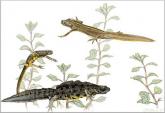Great Crested Newt (or Warty Newt) - Triturus carnifex
Generally large sized newt. Back brown, often with dark mottling and small white spots, which are more obvious during the breeding period.
The belly varies from yellow to orange with large, variously shaped dark marks. Its tail bears an upper and lower crest, with either a smooth or irregularly jagged edge.
Young individuals have a long yellow line running down their backs. Males reach 15 cm in length and have a distinct dorsal and caudal crest; females, which grow up to 20 cm, do not have a dorsal crest.
Can be found all year through in natural and artificial wet habitats with deep, still water. It also frequents slow flowing waters, often remaining on the bottom during the hottest hours of the day or if disturbed, only surfacing to breathe. In droughts or over-eutrophication, it undergoes a complete moult and begins a period of terrestrial life when it is nocturnal, otherwise it enters in a state of quiescence and hides under tree trunks or stones.
During the winter, in harsh temperatures, it hibernates in the water or on the ground, hiding in the mud or beneath the vegetation. Breeding occurs in the autumn, or more frequently in spring.
The male protects his territory from other intruding males and attracts the female with elaborate "dances". The female lays about 250 eggs during a single breeding season, which she attaches singly to plants.
The young hatch after 10-12 days. The tadpoles complete their metamorphosis and become adults after three months, but only reach sexual maturity after three years.
The Great Crested Newt feeds on a wide range of small terrestrial and aquatic animals.




